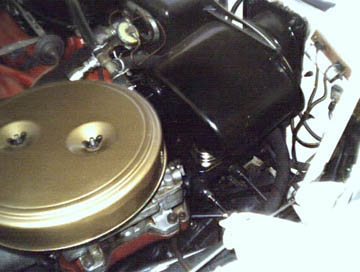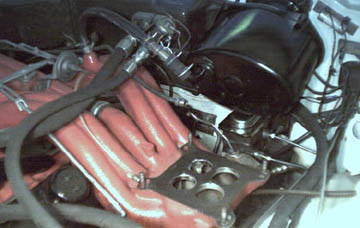
By Dan Reitz Northridge, CA

At first, I was going to use a regular MC for disc brakes. I would have had to machine off enough of the reservoirs to permit the tank and lid to fit beneath the power brake booster. I could not find a suitable disc brake MC as the only ones I found that I thought I could use had a bail to hold the lid on. This would make the profile too high with a smaller reservoir. I finally settled on a MC used in about 1969 for Barracudas and Darts. It has a very low profile but sufficient reservoir capacity to satisfy my needs. (I check the level quite often.) Also, it was originally intended for drum brakes, but the removal of the residual valve in the outlet for the front brakes converts it to a disc brake MC. This I did by tapping the copper seat and pulling it out using a screw and pliers. The residual valve comes right out; the seat is then replaced.
The MC is only 7” in length overall and provides sufficient clearance between it and the carb/ram setup. It installs very easily by tilting the front end down beneath the carb and sliding it back over the mounting studs. The only modification I had to do to the original components was to grind about 0.001 off the circumference of the push rod where it enters the MC. The hole in the MC was just a bit too small. I decided to modify the push rod slightly rather than drill the hole in the MC larger because if I ever needed to replace the MC out on the highway, the new one would drop in without modification.
The 300F does not have a proportioning valve so I disconnected the rear line and plugged the hole in the distribution block. I discarded the old line had new lines made from the MC to distribution block, front and rear. The new tubing is smaller, about 7/64” ID. The front line was terminated in the hole at the top of the block where the original line from the old MC went. The rear line was connected directly to the original rear feed tubing which was disconnected from the terminal block. This provides two separate braking circuits for safety.
The brakes were bled and I experienced a very satisfactory braking response. Much better than with the old single MC. I might add that it is much easier to replenish fluid in the new MC vs the old one. There is a bit more clearance.
The old configuration had a hydraulic rear brake switch screwed into the MC. The new MC does not provide for this. I obtained a mechanical switch from a '62 300, made a mounting bracket, and situated it beneath the dash so that it responds just like it did in the '62. A little extra wiring through the firewall, a couple of bullet connectors, and the switch was in business.
Attached are a couple of photos showing the installation from a top view and the other from a side view to show clearances. Sorry, there is insufficient clearance to take a picture beneath the dash to show the switch installation.

I purchased a brand new MC besides the new lines. My total cost for converting to a dual MC was about $90.